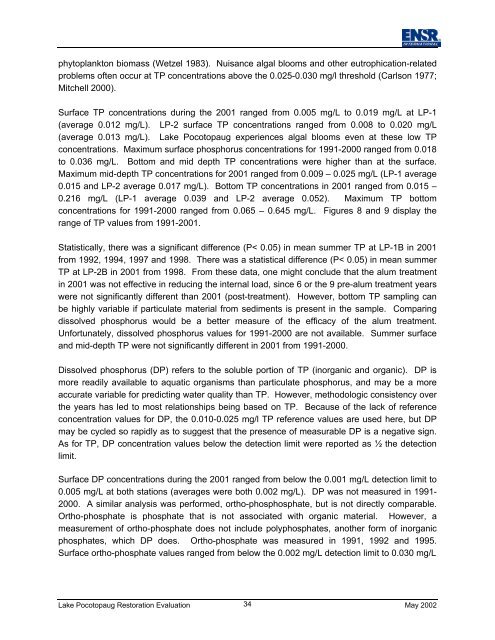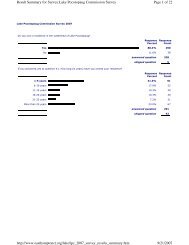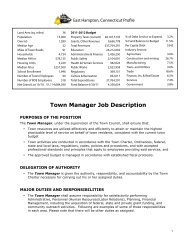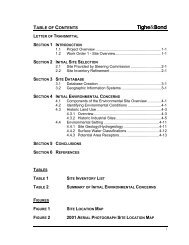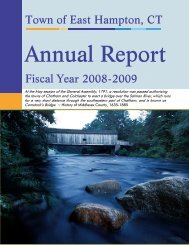Lake Pocotopaug Lake and Watershed Restoration Evaluation ...
Lake Pocotopaug Lake and Watershed Restoration Evaluation ...
Lake Pocotopaug Lake and Watershed Restoration Evaluation ...
Create successful ePaper yourself
Turn your PDF publications into a flip-book with our unique Google optimized e-Paper software.
phytoplankton biomass (Wetzel 1983). Nuisance algal blooms <strong>and</strong> other eutrophication-relatedproblems often occur at TP concentrations above the 0.025-0.030 mg/l threshold (Carlson 1977;Mitchell 2000).Surface TP concentrations during the 2001 ranged from 0.005 mg/L to 0.019 mg/L at LP-1(average 0.012 mg/L). LP-2 surface TP concentrations ranged from 0.008 to 0.020 mg/L(average 0.013 mg/L). <strong>Lake</strong> <strong>Pocotopaug</strong> experiences algal blooms even at these low TPconcentrations. Maximum surface phosphorus concentrations for 1991-2000 ranged from 0.018to 0.036 mg/L. Bottom <strong>and</strong> mid depth TP concentrations were higher than at the surface.Maximum mid-depth TP concentrations for 2001 ranged from 0.009 – 0.025 mg/L (LP-1 average0.015 <strong>and</strong> LP-2 average 0.017 mg/L). Bottom TP concentrations in 2001 ranged from 0.015 –0.216 mg/L (LP-1 average 0.039 <strong>and</strong> LP-2 average 0.052). Maximum TP bottomconcentrations for 1991-2000 ranged from 0.065 – 0.645 mg/L. Figures 8 <strong>and</strong> 9 display therange of TP values from 1991-2001.Statistically, there was a significant difference (P< 0.05) in mean summer TP at LP-1B in 2001from 1992, 1994, 1997 <strong>and</strong> 1998. There was a statistical difference (P< 0.05) in mean summerTP at LP-2B in 2001 from 1998. From these data, one might conclude that the alum treatmentin 2001 was not effective in reducing the internal load, since 6 or the 9 pre-alum treatment yearswere not significantly different than 2001 (post-treatment). However, bottom TP sampling canbe highly variable if particulate material from sediments is present in the sample. Comparingdissolved phosphorus would be a better measure of the efficacy of the alum treatment.Unfortunately, dissolved phosphorus values for 1991-2000 are not available. Summer surface<strong>and</strong> mid-depth TP were not significantly different in 2001 from 1991-2000.Dissolved phosphorus (DP) refers to the soluble portion of TP (inorganic <strong>and</strong> organic). DP ismore readily available to aquatic organisms than particulate phosphorus, <strong>and</strong> may be a moreaccurate variable for predicting water quality than TP. However, methodologic consistency overthe years has led to most relationships being based on TP. Because of the lack of referenceconcentration values for DP, the 0.010-0.025 mg/l TP reference values are used here, but DPmay be cycled so rapidly as to suggest that the presence of measurable DP is a negative sign.As for TP, DP concentration values below the detection limit were reported as ½ the detectionlimit.Surface DP concentrations during the 2001 ranged from below the 0.001 mg/L detection limit to0.005 mg/L at both stations (averages were both 0.002 mg/L). DP was not measured in 1991-2000. A similar analysis was performed, ortho-phosphosphate, but is not directly comparable.Ortho-phosphate is phosphate that is not associated with organic material. However, ameasurement of ortho-phosphate does not include polyphosphates, another form of inorganicphosphates, which DP does. Ortho-phosphate was measured in 1991, 1992 <strong>and</strong> 1995.Surface ortho-phosphate values ranged from below the 0.002 mg/L detection limit to 0.030 mg/L<strong>Lake</strong> <strong>Pocotopaug</strong> <strong>Restoration</strong> <strong>Evaluation</strong> 34May 2002


